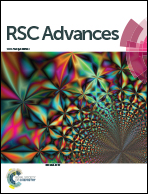One-pot microwave-assisted in situ reduction of Ag+ and Au3+ ions by Citrus limon extract and their carbon-dots based nanohybrids: a potential nano-bioprobe for cancer cellular imaging
Abstract
In the present study, we demonstrate a rapid, in situ reduction of metal (Ag+ and Au3+) ions and subsequent carbonization of Citrus limon (lemon) extract to synthesize highly luminescent carbon-dots (C-dots) and their metal nanohybrids (MCNs) using one-pot microwave (MW) assisted technique within 6 min. In principle, L-ascorbic acid, citric acid and flavonoids reduce metal ions into corresponding metal nanoparticles followed by carbonization of carbohydrates in the lemon extract along with externally added ethylenediamine (EDA) to form EDA-functionalized C-dots based nanohybrids. The synthesized pristine C-dots, Ag/C-dot and Au/C-dot nanohybrids (<5 nm) colloidal solution exhibited bright photoluminescence (PL) at ∼515 nm with significant quantum yield (QY) of 48.3%, 46.2%, 62.2% and PL emission lifetime of 3.6 ns, 9.4 ns and 9.0 ns respectively. The reduced PL intensity and QY for Ag/C-dot nanohybrids could be due to fluorescence resonance energy transfer (FRET) while enhanced PL intensity and QY for Au/C-dot nanohybrids could be attributed to surface plasmonic resonance (SPR), when compared to pristine C-dots. These C-dots-based nanohybrids exhibited no signs of cytotoxicity in colon cancer cell lines (SW-480) and were easily internalized for fluorescence bioimaging. Thus, the MW-assisted sustainable synthesis of pristine C-dots and metal/C-dot nanohybrids derived from natural lemon extract can be exhibited as eco-friendly intense potential nano-bioprobes for cancer cellular imaging applications.


 Please wait while we load your content...
Please wait while we load your content...